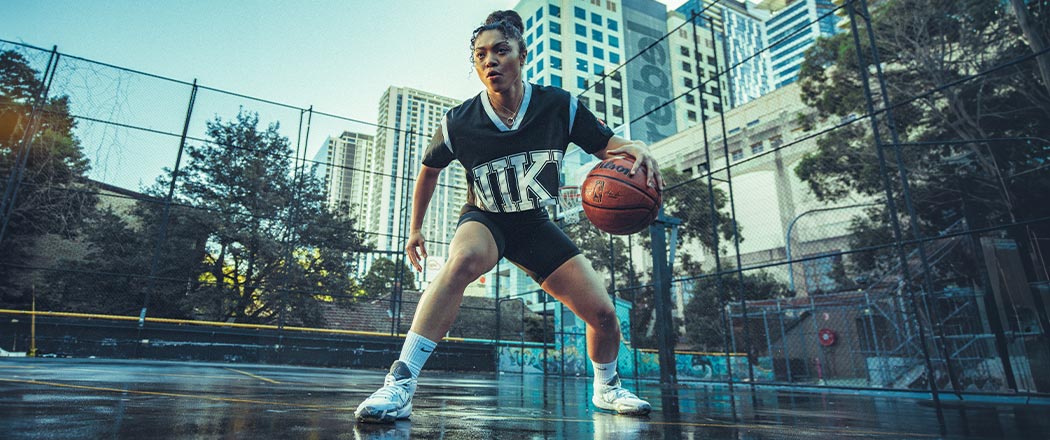Whether you're a seasoned pro or a newbie on the court, choosing the right basketball can significantly enhance your game. The right ball can improve your dribbling, shooting, and overall performance. But how do you choose the perfect basketball? Let's dive in and find out.

Understanding Basketball Sizes
First things first, basketballs come in various sizes, and the right size for you depends on your age and skill level. The three main sizes are size 5, size 6, and size 7.
SIZE 5 |
SIZE 6 |
SIZE 7 |
| Junior basketball playersaged between 8 - 11years old | Official size for the WNBL,high school and universityleagues for players overthe age of 12 | Official size of the NBAand other competitions,designed for players overthe age of 14 |
Size 3 and 4
Also known as mini basketballs, these are the smallest sizes you can get for a basketball. These balls have been designed with small hands in mind, making them perfect for kids between 4 - 8 years old for size 4, and kids under 3 years old for size 3. Spalding release an Aussie Hoops range that extends to size 4 for 5-9 year olds
Size 5
Size 5 balls are perfect for youngsters, typically aged 8 - 11. These balls have a circumference of 27.5 inches, making them easy for smaller hands to handle.
Size 6
Size 6 balls, with a 28.5-inch circumference, are suitable for women, and boys aged 12 - 14. This size of balls is also the official size for many women’s leagues, including the WNBA.
Size 7
Finally, size 7 balls, with a 29.5-inch circumference are used in the NBA, and by menand boys aged 14 and up.
Can women play with a size 7 ball instead of a size 6?
Certain leagues may restrict what size is used during competition game-day, for example, men’s leagues only allow size 7 to be used. Women use size 6. The exception to this rule is mixed basketball leagues that sometimes means Women will use a size 7.
The reason many women’s leagues use a size 6 over a size 7 is due to ball vs hand size.
Indoor vs Outdoor Basketballs
Next, let's talk about the court. Where you play can influence the type of basketball you need.
Indoor:
Indoor basketballs are typically made with full-grain leather, which provides an excellent grip but can wear out quickly on rough outdoor surfaces.
Outdoor:
If you're an outdoor player, opt for a rubber or synthetic leather basketball. They're durable and can withstand the harsh conditions of outdoor courts.
If you play on a mixture of both indoor and outdoor courts, then a synthetic leather or a composite material ball will be able to handle both surfaces with ease.
Which Basketball Material is Best
Basketballs come in many different materials, from high-end leather to durable rubber. Each is typically better suited for either indoor or outdoor. Let’s break it down:
Leather:
Leather basketballs are the gold standard, providing an unmatchedgrip and feel. However, they typically require a break-in period and are the priciest. They are also best suited for indoor courts since the rough outdoor surfaces can damage the material.
Synthetic:
Synthetic leather or composite balls offer a good grip, require no break-in time, and are more affordable, making them a popular choice for many players, in particular those who play on indoor and outdoor surfaces.
Rubber:
Rubber basketballs are the most durable and least expensive, but they lack the professional feel of leather and synthetic balls. If you play exclusively outdoors, then a rubber ball is a great option for you.
What’s the Difference Between Training & Game Balls
Now, are you buying a basketball for training or game day?
Basketballs for training:
Basketballs used in training are often the actual competition ball for feel familiarity and kinesthetic elements, or more value options given the higher price of competition balls. Composite balls are typically the happy medium between game-ball feel and affordable price.
Basketballs for competition:
Game balls, on the other hand, are designed according to professional standards and are perfect for competitive play.
There is no hard and fast rule that you only use training balls when training, in fact, many players use replicas of their game day balls to practice as well. It’s a good idea to have a mix of training and competition basketballs so you can vary your training as needed.
What Else to Consider When Buying a Basketball?
Buying a basketball is a fairly straightforward process. Find the size you need, choose your preferred material and away you go. However, here are a few extra considerations to make sure you buy the perfect basketball for your needs:
Grip and feel:
Consider your personal preference in terms of feel and grip. Some players prefer a softer feel, while others like a ball with a firm grip. Thiswill often be dictated by the material, so choose accordingly.
Brands:
When it comes to brands, there are several reputable ones to choose from, including Spalding, Wilson, Nike, Jordan and Molten These brands offer a variety of basketballs to cater to different needs and preferences.
Design:
Whether you like a traditional look or want your favourite team or player’s colours on it, basketballs come in a huge variety of styles to choose from.
Budget:
Like most sporting equipment, basketballs also vary in price. Less expensive basketballs will be typically made from rubber or synthetic leather, while more expensive options will be made from leather and be either replica or authentic game balls.
Remember, the best basketball for you is one that feels right in your hands and matches your playing style and conditions. So, whether you're shooting hoops in your backyard or playing in a competitive league, take the time to choose the right basketball. It can make a world of difference to your game!
Shop the complete collection of basketballs at rebel now from all the top brands, including Wilson, Molten, Nike, Spalding, and Jordan.